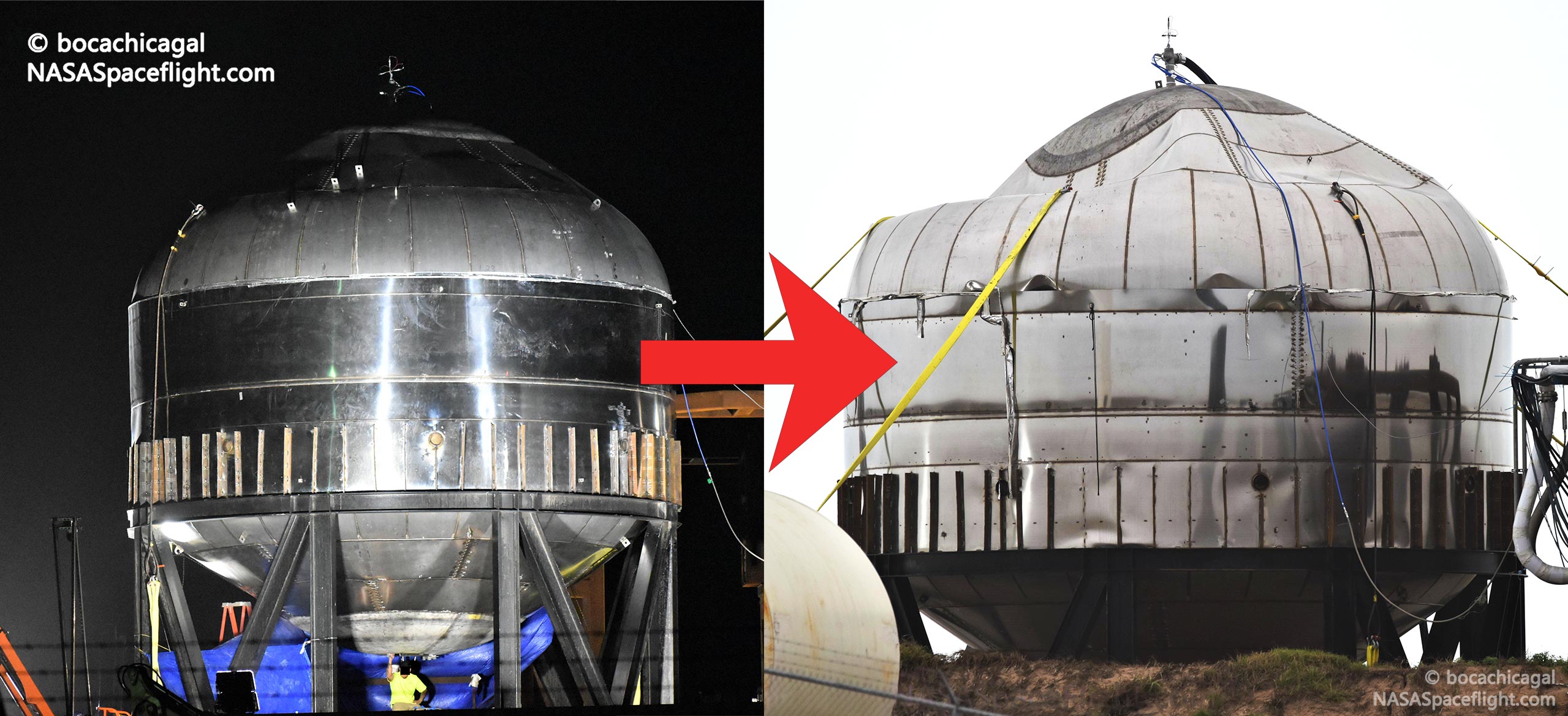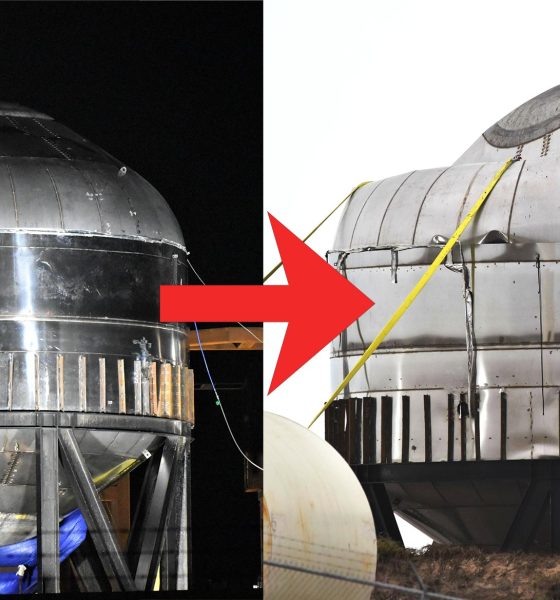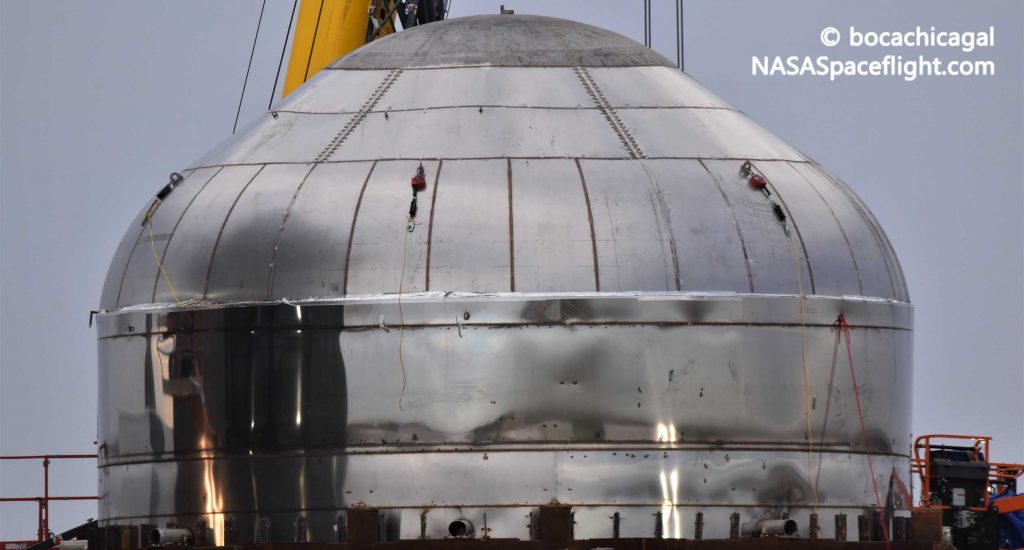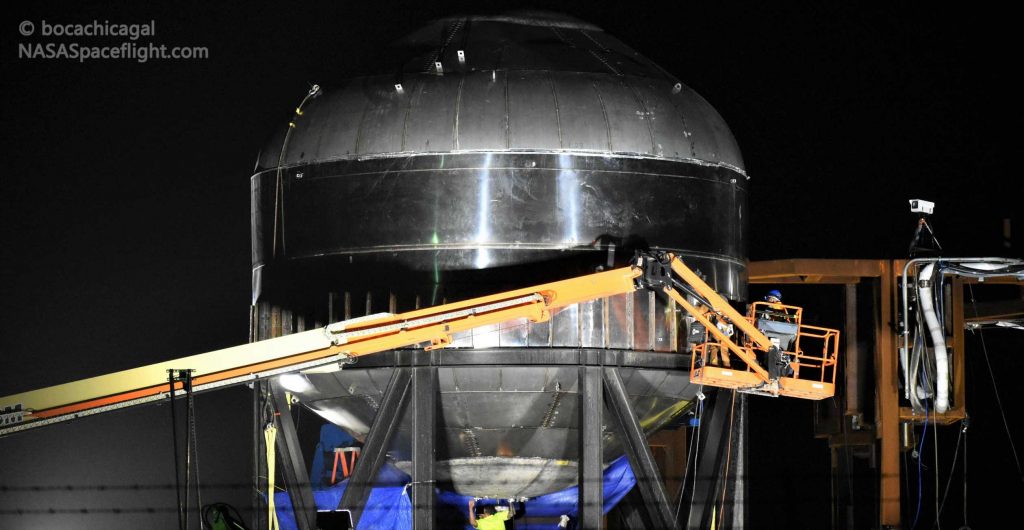

News
SpaceX just blew up a Starship tank on purpose and Elon Musk says the results are in
Before dawn on January 10th, SpaceX technicians and engineers intentionally blew up a miniature Starship tank in order to test recently-upgraded manufacturing and assembly methods, likely to be used to build the first Starships bound for flight tests and orbit.
SpaceX CEO Elon Musk quickly weighed in on Twitter later the same day, revealing some crucial details about the Starship tank test and effectively confirming that it was a success. While somewhat unintuitive, this is the second time SpaceX has intentionally destroyed largely completed Starship hardware in order to determine the limits of the company’s current methods of production and assembly.
Most notably, on November 20th, SpaceX is believed to have intentionally overpressurized the Starship Mk1 prototype in a very similar – albeit larger-scale – test, destroying the vehicle and sending its top tank dome flying hundreds of feet into the air. It’s generally believed that SpaceX (or perhaps even just Musk) decided that Starship Mk1 was not fit to fly, leading the company to switch gears and deem the prototype a “manufacturing pathfinder” rather than the first Starship to fly – which Musk had explicitly stated just a few months prior.
Bopper (Baby StarPopper) this morning after the overpressure event at SpaceX Boca Chica. ??@NASASpaceflight https://t.co/nCG7E9XtKM pic.twitter.com/PRTDQvvlRh— Mary (@BocaChicaGal) January 10, 2020
Dome to barrel weld made it to 7.1 bar, which is pretty good as ~6 bar is needed for orbital flight. With more precise parts & better welding conditions, we should reach ~8.5 bar, which is the 1.4 factor of safety needed for crewed flight.— Buff Mage (@elonmusk) January 10, 2020
Instead, Starship Mk1 suffered irreparable damage during its pressurization test and was rapidly scrapped in the weeks following, although several segments were thankfully salvaged – perhaps for use on future prototypes. Along those lines, it can arguably be said that the results from the mini Starship tank’s Jan. 10 pop test have paved the way for SpaceX to build the first truly flightworthy Starship prototypes – potentially all the way up to the first spaceworthy vehicles.
Hours after the test, Musk revealed that the Starship test tank failed almost exactly where and how SpaceX expected it would, bursting when the weld joining the upper dome and tank wall failed. Critically, the tank reached a maximum sustained pressure of 7.1 bar (103 psi), some 18% over the operating pressure (6 bar/87 psi) Musk says Starship prototypes will need to be declared fully capable of orbital test flights. In other words, given the tank’s size, it survived an incredible ~20,000 metric tons (45 million lbf) of force spread out over its surface area, equivalent to about 20% the weight of an entire US Navy aircraft carrier.
Musk also revealed that SpaceX will require Starships to survive a minimum of 140% of that operating pressure before the company will allow the spacecraft to launch humans.
Some have less than generously taken to smugly noting that several modern spaceflight and engineering standards require that launch vehicle tankage be rated to survive no less than 125% of their operating pressure, while this test tank would be rated for less than 118% under identical conditions. However, this ignores several significant points of interest. First and foremost, the Starship test tank intentionally destroyed on January 10th was assembled from almost nothing – going from first weld to a completed pressurization test – in less than three weeks (20 days).
Second, all visible welding and assembly work was performed outside in the South Texas elements with only a minor degree of protection from the coastal winds and environment. Although some obvious tweaks were made to the specific methods used to assembly the prototype tank, it also appears that most of the welding was done by hand. For the most part, in other words, the methods used to build this improved test article were largely unchanged compared to Starship Mk1, which is believed to have failed around 3-5 bar (40-75 psi).
Additionally, it appears that almost all aspects of this test tank have smaller structural margins, meaning that the tank walls and domes are likely using steel stock that is substantially thinner than what was used on Starship Mk1. Nevertheless, thanks to the addition of continuous (single-weld) steel rings, a tweaked dome layout, and slightly refined welding, this test tank has performed anywhere from 20% to 200+% better than Starship Mk1 – again, all while coming together from scratch in a period of less than three weeks.

As Musk notes, with relatively minor improvements to welding conditions and the manufacturing precision of Starship rings and domes, SpaceX can likely ensure that Starships (and thus Super Heavy boosters) will be able to survive pressures greater than 8.5 bar (125 psi), thus guaranteeing a safety margin of at least 40%. Even a minor improvement of ~6% would give vehicles a safety margin of 125%, enough – in the eyes of engineering standards committees – to reasonably certify Starships for orbital test flights.


All things considered, it’s safe to assume that SpaceX is going to begin building and assembling Starship SN01 (formerly Mk3) hardware almost immediately. Given that this test tank took just 20 days to assemble, it’s safe to say that the upgraded prototype’s tank section could be completed in just a handful of weeks. Stay tuned for progress reports.
Check out Teslarati’s Marketplace! We offer Tesla accessories, including for the Tesla Cybertruck and Tesla Model 3.

Elon Musk
Elon Musk’s X will start using a Tesla-like software update strategy
The initiative seems designed to accelerate updates to the social media platform, while maintaining maximum transparency.

Elon Musk’s social media platform X will adopt a Tesla-esque approach to software updates for its algorithm.
The initiative seems designed to accelerate updates to the social media platform, while maintaining maximum transparency.
X’s updates to its updates
As per Musk in a post on X, the social media company will be making a new algorithm to determine what organic and advertising posts are recommended to users. These updates would then be repeated every four weeks.
“We will make the new 𝕏 algorithm, including all code used to determine what organic and advertising posts are recommended to users, open source in 7 days. This will be repeated every 4 weeks, with comprehensive developer notes, to help you understand what changed,” Musk wrote in his post.
The initiative somewhat mirrors Tesla’s over-the-air update model, where vehicle software is regularly refined and pushed to users with detailed release notes. This should allow users to better understand the details of X’s every update and foster a healthy feedback loop for the social media platform.
xAI and X
X, formerly Twitter, has been acquired by Elon Musk’s artificial intelligence startup, xAI last year. Since then, xAI has seen a rapid rise in valuation. Following the company’s the company’s upsized $20 billion Series E funding round, estimates now suggest that xAI is worth tens about $230 to $235 billion. That’s several times larger than Tesla when Elon Musk received his controversial 2018 CEO Performance Award.
As per xAI, the Series E funding round attracted a diverse group of investors, including Valor Equity Partners, Stepstone Group, Fidelity Management & Research Company, Qatar Investment Authority, MGX, and Baron Capital Group, among others. Strategic partners NVIDIA and Cisco Investments also continued support for building the world’s largest GPU clusters.
News
Tesla FSD Supervised wins MotorTrend’s Best Driver Assistance Award
The decision marks a notable reversal for the publication from prior years, with judges citing major real-world improvements that pushed Tesla’s latest FSD software ahead of every competing ADAS system.

Tesla’s Full Self-Driving (Supervised) system has been named the best driver-assistance technology on the market, earning top honors at the 2026 MotorTrend Best Tech Awards.
The decision marks a notable reversal for the publication from prior years, with judges citing major real-world improvements that pushed Tesla’s latest FSD software ahead of every competing ADAS system. And it wasn’t even close.
MotorTrend reverses course
MotorTrend awarded Tesla FSD (Supervised) its 2026 Best Tech Driver Assistance title after extensive testing of the latest v14 software. The publication acknowledged that it had previously criticized earlier versions of FSD for erratic behavior and near-miss incidents, ultimately favoring rivals such as GM’s Super Cruise in earlier evaluations.
According to MotorTrend, the newest iteration of FSD resolved many of those shortcomings. Testers said v14 showed far smoother behavior in complex urban scenarios, including unprotected left turns, traffic circles, emergency vehicles, and dense city streets. While the system still requires constant driver supervision, judges concluded that no other advanced driver-assistance system currently matches its breadth of capability.
Unlike rival systems that rely on combinations of cameras, radar, lidar, and mapped highways, Tesla’s FSD operates using a camera-only approach and is capable of driving on city streets, rural roads, and freeways. MotorTrend stated that pure utility, the ability to handle nearly all road types, ultimately separated FSD from competitors like Ford BlueCruise, GM Super Cruise, and BMW’s Highway Assistant.
High cost and high capability
MotorTrend also addressed FSD’s pricing, which remains significantly higher than rival systems. Tesla currently charges $8,000 for a one-time purchase or $99 per month for a subscription, compared with far lower upfront and subscription costs from other automakers. The publication noted that the premium is justified given FSD’s unmatched scope and continuous software evolution.
Safety remained a central focus of the evaluation. While testers reported collision-free operation over thousands of miles, they noted ongoing concerns around FSD’s configurable driving modes, including options that allow aggressive driving and speeds beyond posted limits. MotorTrend emphasized that, like all Level 2 systems, FSD still depends on a fully attentive human driver at all times.
Despite those caveats, the publication concluded that Tesla’s rapid software progress fundamentally reshaped the competitive landscape. For drivers seeking the most capable hands-on driver-assistance system available today, MotorTrend concluded Tesla FSD (Supervised) now stands alone at the top.
News
Elon Musk’s Grokipedia surges to 5.6M articles, almost 79% of English Wikipedia
The explosive growth marks a major milestone for the AI-powered online encyclopedia, which was launched by Elon Musk’s xAI just months ago.

Elon Musk’s Grokipedia has grown to an impressive 5,615,201 articles as of today, closing in on 79% of the English Wikipedia’s current total of 7,119,376 articles.
The explosive growth marks a major milestone for the AI-powered online encyclopedia, which was launched by Elon Musk’s xAI just months ago. Needless to say, it would only be a matter of time before Grokipedia exceeds English Wikipedia in sheer volume.
Grokipedia’s rapid growth
xAI’s vision for Grokipedia emphasizes neutrality, while Grok’s reasoning capabilities allow for fast drafting and fact-checking. When Elon Musk announced the initiative in late September 2025, he noted that Grokipedia would be an improvement to Wikipedia because it would be designed to avoid bias.
At the time, Musk noted that Grokipedia “is a necessary step towards the xAI goal of understanding the Universe.”
Grokipedia was launched in late October, and while xAI was careful to list it only as Version 0.1 at the time, the online encyclopedia immediately earned praise. Wikipedia co-founder Larry Sanger highlighted the project’s innovative approach, noting how it leverages AI to fill knowledge gaps and enable rapid updates. Netizens also observed how Grokipedia tends to present articles in a more objective manner compared to Wikipedia, which is edited by humans.
Elon Musk’s ambitious plans
With 5,615,201 total articles, Grokipedia has now grown to almost 79% of English Wikipedia’s article base. This is incredibly quick, though Grokipedia remains text-only for now. xAI, for its part, has now updated the online encyclopedia’s iteration to v0.2.
Elon Musk has shared bold ideas for Grokipedia, including sending a record of the entire knowledge base to space as part of xAI’s mission to preserve and expand human understanding. At some point, Musk stated that Grokipedia will be renamed to Encyclopedia Galactica, and it will be sent to the cosmos.
“When Grokipedia is good enough (long way to go), we will change the name to Encyclopedia Galactica. It will be an open source distillation of all knowledge, including audio, images and video. Join xAI to help build the sci-fi version of the Library of Alexandria!” Musk wrote, adding in a later post that “Copies will be etched in stone and sent to the Moon, Mars and beyond. This time, it will not be lost.”








